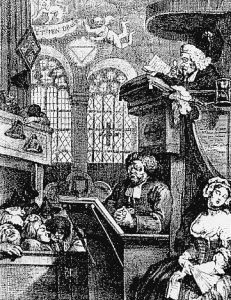Religion: England and Wales
Religious, political and social issues were still closely interconnected in eighteenth-century England. As the established church, the Church of England prevailed, while Dissenters, also known as non-conformists, refused to conform to its authority. From 1738 onwards, there appeared another, potentially schismatical, movement, deriving its name from an initially derogatory nickname, “the people called Methodists”.
Though disadvantaged by a set of “penal laws”, most Roman Catholics were well tolerated in practice by their neighbourhood, except in times of dynastic crisis or popular disturbances.
As for Jews, the spectacular repeal, in 1753, of the bill in favour of their naturalisation probably postponed their integration into British society for almost 100 years.
The Church of England
The political life of the established church in the 18th century was characterized by its erastianism. Anglican clergy did not hesitate in the least to openly commit themselves on political questions, when there were elections or sessions at the Assizes. The Jacobite rebellions of 1715 and 1745 gave the latitudinarian preachers the opportunity to make their support clear for the established order and the Hanover dynasty. Conversely, politicians readily exerted their influence in the life of the church. Patronage and nepotism were the rule in a world where the distribution of posts and ecclesiastic dignities depended on political power. It is not surprising in this case to note a certain favouritism in favour of the Whig clergy under Walpole’s government.
At the mercy of influential protectors, to whom they owed careers and promotions, numerous clergymen were reduced to pluralism, and therefore to non-residence. This is because the clergy was a rigidly hierarchical profession. Indeed, there was nothing to compare between the fortune of certain Bishops and the meagre stipends of the lower clergy, between the poor diocese and the rich regions. The scale of annual incomes went from £50 to more than £2000. In the Cumbria region to the north-west of England, a minister could expect an income 60% lower than that of his fellow clergymen. As a result, the clergy had an ambiguous and complex social status. Despite a liberal education, which made them share the ideologies of the upper classes, numerous ministers lived scarcely better than their poor parishioners. Literature bears witness to this, with the striking example of Pastor Adams, who earned only £23 at the age of 56 in Fielding’s Joseph Andrews.
The main source of church income came from the tithe, which contributed to the development of a certain anticlericalism in rural areas. Otherwise, it is difficult to evaluate the reputation of spiritual lethargy that the clergy attracted, although devoted and not completely without professional conscientiousness. There was no lack of vicars to carry out the pastoral responsibilities of non-residential pastors.
It is no doubt necessary to find another explanation for the disaffection of the public for traditional churches, and the emergence of Methodism. The fact that the former parishes were, to a certain extent, maladapted to urban growth is no doubt an element that cannot be neglected.
Erastianism
The idea of absolute state primacy over the church is known as Erastianism. The doctrine derives its name from Thomas Erastus (1524-83), a Swiss Protestant theologian who held that only the state could punish such offenders because civil authorities had final jurisdiction in all areas, even in matters such as religion & whose book had a powerful influence on the English theories of state control over the church during the 17th and 18th centuries.
Latitudinarianism
The word was coined around the time of the Restoration and often referred pejoratively to those ’latitude-men’, or ministers of the Church of England, who were prepared to grant some amount of religious and political toleration to protestant Dissenters.
It was gradually used in a broader, looser meaning denoting an open-minded and liberal approach permitting freedom of attitude or behaviour in political and religious matters, that was widespread among whig circles and in what came to be known as the ’low church’.
Spiritual lethargy

- Hogarth, The Sleeeping Congregation (1736)
- a satire on the spiritual lethargy of the Church.
Similar engravings against the Church of Scotland were also published.
[click on the picture to enlarge it]

